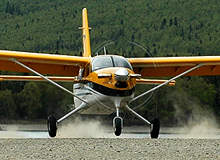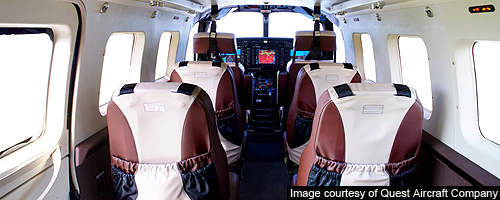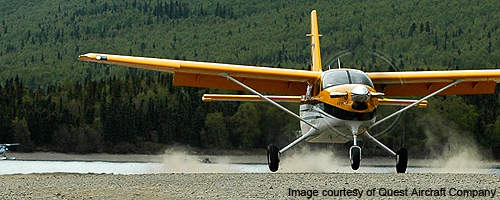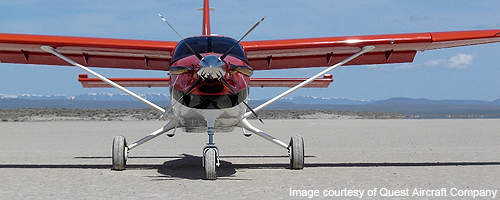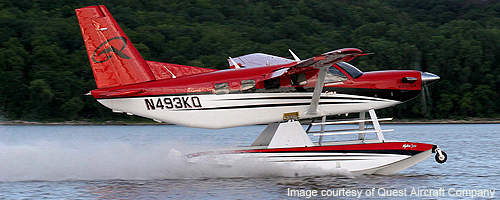Quest Kodiak, also known as Mountain Rocket, is a single engine, ten-seat utility aircraft designed and manufactured by Quest Aircraft Company of Idaho, US.
The aircraft can carry passengers and cargo even in adverse weather conditions adhering to both visual and instrument flight rules (VFR & IFR). It can operate in both day and night conditions.
The development of the Kodiak began in 1985. It received the Federal Aviation Administration’s (FAA) type certification in July 2007. The deliveries of Kodiak to customers (mostly missionary groups) began in December 2007. The production certification was obtained in September 2009.
The aircraft is fitted with an external cargo compartment (ECC), and was displayed at AirVenture in July 2010. The ECC, manufactured by Aerocet, provides additional storage space of 65ft³ to store 750lb of luggage. The baggage can be loaded into the compartment through pre-loaded storage bins.
Orders and deliveries
Kodiak was first procured by JAARS, a non-profit organisation in January 2009. JAARS ordered five aircraft to be used for delivery of translated Bibles to remote areas.
MAF (Mission Aviation Fellowship) was supplied a Kodiak along with four crew members in January 2009 to support relief efforts in the aftermath of the massive earthquake in Haiti.
Kodiak is the fourth aircraft in the MAF fleet that participated in the disaster relief programme. MAF is planning to procure 20 more Kodiaks in the next 10 years for replacing its existing Cessna 206 aircraft.
Quest Aircraft will supply 13 Kodiaks to Indonesia (8), Afghanistan (2), Democratic Republic of Congo (2) and Nepal (1) by 2013.
Design
Kodiak has been designed to take-off and land in short and unpaved airstrips rather than prepared or surfaced runways. The pointed cowlings of the aircraft increase the take-off thrust. The tip clearance of 0.48m blade allows the Kodiak to operate on rough terrains.
The fixed tricycle type landing gear can be easily converted to float operations. The wing struts and engine mounts were designed from the beginning to accept float landing loads. The doors are massively wide and enable patients or stretchers to be lifted easily into the cargo compartment.
Features
The aircraft utilises jet fuel rather than avgas (aviation gas). It is equipped with a roll up door, handrails, a wind deflector, jump lights, and static line anchor cables. A wing-mounted video camera captures imagery of the disaster field.
Flight deck
The glass cockpit accommodates a pilot and a co-pilot. The Garmin G1000 avionics suite includes a flight instrumentation system, an S-Tec 55X autopilot, a weather monitoring system, and a terrain collision and avoidance system (TCAS). It is also fitted with three 10in multifunctional displays (MFD) which show navigation, weather, traffic and engine data.
The aircraft is also equipped with two cockpit doors of 0.78m x 1.29m dimension. The glass canopy of the Kodiak provides clear visibility.
The flight deck also features a Garmin Skywatch or Stormscope package, Garmin XM Infotainment, Garmin synthetic vision, an Artex C406-N emergency locator transmitter or global positioning system (ELT-GPS), a Quest RGB chip detector and a Garmin chart view enable card.
Cabin
The Kodiak cabin has plenty of leg space for passengers. The cabin is fitted with three doors and can accommodate 10 passengers. The door sill height of the cabin is 0.96m. There is a cargo door on both sides. The cargo compartment accommodates up to 3,100lb (1,400kg) of payload.
The length and width of the cabin are 4.8m and 1.37m respectively. Its height is 1.44m. The cabin is also integrated with a Quest cargo pod, a Quest tundra interior, a Quest timberline interior, and a TKS ice protection system manufactured by CAV Aerospace.
Engine
The Kodiak is powered by a single Pratt & Whitney Canada PT6A-34 turboprop engine and a Hartzell four blade aluminium propeller. The engine can generate 750hp (559.5kW) of output power. Its maximum continuous power is 700hp (522.2kW).
The propeller can rotate at a constant speed of 2,200rpm. The diameter and tip clearance of the propeller are 2.43m and 0.48m respectively.
An epicyclic speed reduction gearbox installed in the engine reduces propeller noise by optimising output speed. The engine is also incorporated with a multi-stage axial and single-stage centrifugal compressor, a reverse flow combustor and a single-stage compressor turbine.
The length and diameter of the engine are 1.57m and 0.48m respectively.
Performance
The Kodiak can climb at the rate of 1,371ft/m. The maximum cruise and stall speed of the aircraft are 338km/h and 142km/h respectively. Its service ceiling is 7,620m. The take-off and landing distance of the Kodiak are 305m and 214m respectively.
It can loiter in air for around five hours. The aircraft weighs 1,710kg and its maximum take-off weight is 3,290kg.

